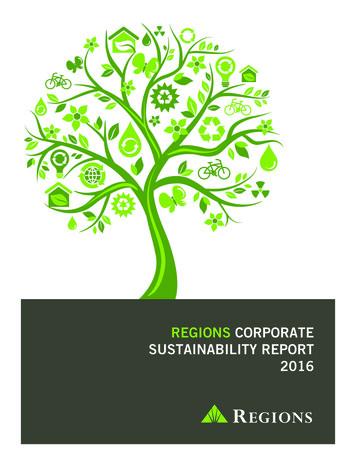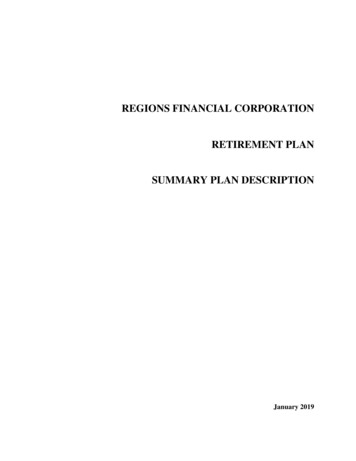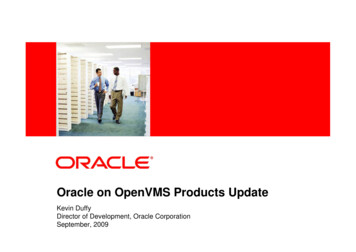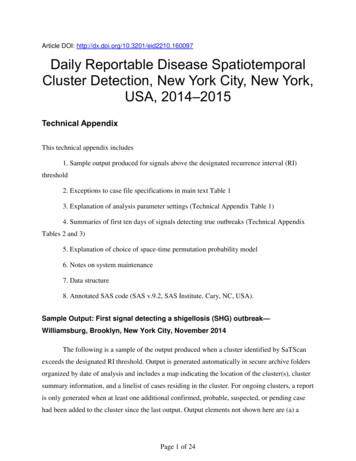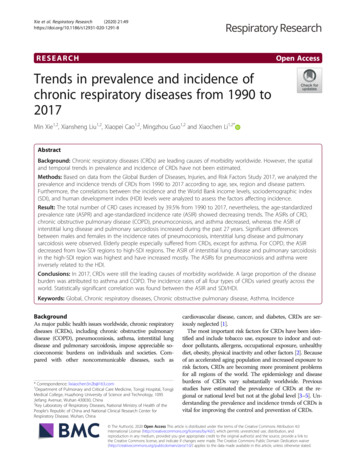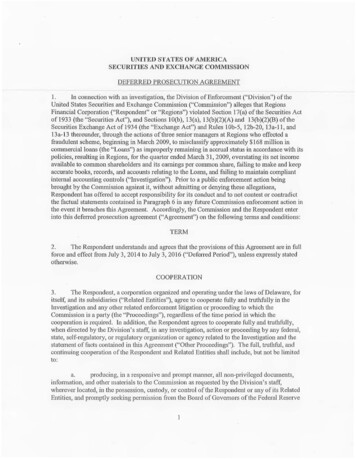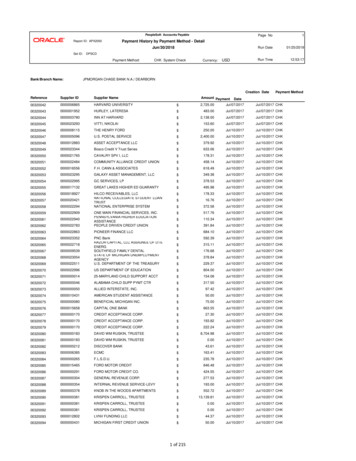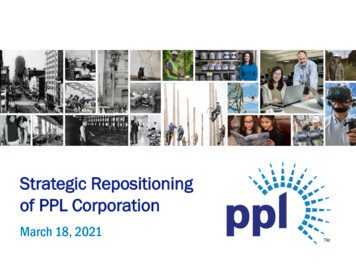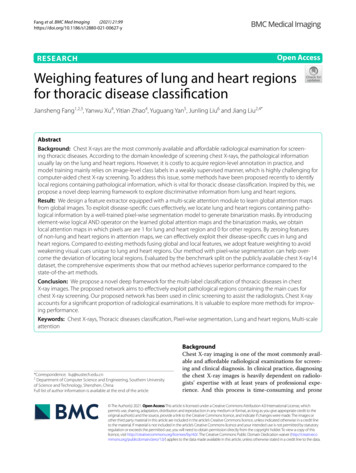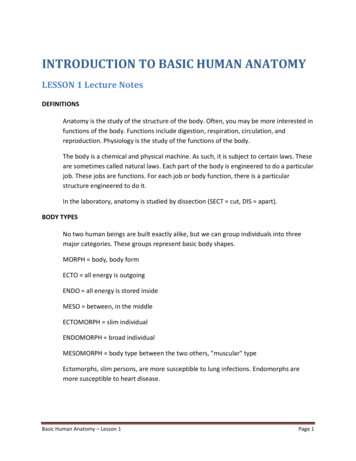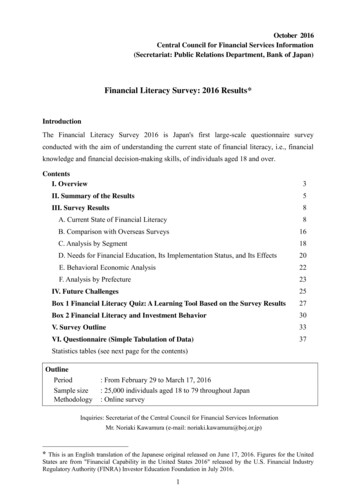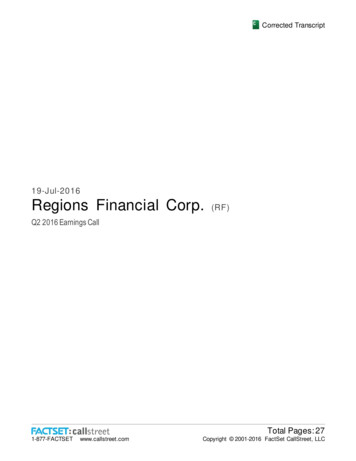
Transcription
Corrected Transcript19-Jul-2016Regions Financial Corp.(RF)Q2 2016 Earnings CallTotal Pages: 271-877-FACTSETwww.callstreet.comCopyright 2001-2016 FactSet CallStreet, LLC
Regions Financial Corp.Corrected Transcript(RF)Q2 2016 Earnings Call19-Jul-2016CORPORATE PARTICIPANTSDana W. NolanDavid J. Turner, Jr.Executive Vice President - Head of Investor RelationsChief Financial Officer & Senior Executive Vice PresidentO. B. Grayson HallBarbara I. GodinChairman, President & Chief Executive OfficerChief Credit Officer & Senior Executive VP, Regions Financial Corp.OTHER PARTICIPANTSMarty MosbyErika P. NajarianVining Sparks IBG LPBank of America Merrill LynchJennifer DembaJohn PancariSunTrust Robinson Humphrey, Inc.Evercore Group LLCGeoffrey ElliottPaul J. MillerAutonomous Research LLPFBR Capital Markets & Co.Matthew Hart BurnellMatthew Derek O'ConnorKen UsdinVivek JunejaDavid EadsGerard CassidyStephen Kendall ScoutenChristopher William MarinacWells Fargo Securities LLCJefferies LLCDeutsche Bank Securities, Inc.JPMorgan Securities LLCUBS Securities LLCRBC Capital Markets LLCSandler O'Neill & Partners LPFIG Partners LLCMichael RoseRaymond James & Associates, Inc.21-877-FACTSETwww.callstreet.comCopyright 2001-2016 FactSet CallStreet, LLC
Regions Financial Corp.Corrected Transcript(RF)Q2 2016 Earnings Call19-Jul-2016MANAGEMENT DISCUSSION SECTIONOperator: Good morning, and welcome to the Regions Financial Corporation's Quarterly Earnings Call. Myname is Paula, and I'll be your operator for today's call. I would like to remind everyone that all participant phonelines have been placed on listen-only. At the end of the call, there will be a question-and-answer session.[Operator Instructions]I will now turn the call over to Ms. Dana Nolan to begin.Dana W. NolanExecutive Vice President - Head of Investor RelationsThank you, Paula. Good morning, and welcome to Regions' second quarter 2016 earnings conference call.Participating on the call are Grayson Hall, Chief Executive Officer; and David Turner, Chief Financial Office r.Other members of senior management are also present and available to answer questions.A copy of the slide presentation we will reference throughout this call, as well as our earnings release andearnings supplement are available under the Investor Relations section at regions.com.I'd also like to caution you that we may make forward-looking statements during today's call that are subject torisks and uncertainties. Factors that may cause actual results to differ materially from expectations are detai led inour SEC filings, including the Form 8-K filed today containing our earnings release.I will now turn the call over to Grayson.O. B. Grayson HallChairman, President & Chief Executive OfficerGood morning, and thank you for joining our call. Second quarter results reflect continued momentum in 2006(sic) [2016] and demonstrate that we are successfully executing on our strategic priorities. We are pleased by ourcontinued progress, despite a challenging and somewhat volatile economic backdrop.For the second quarter, we reported earnings available to common shareholders of 259 million and earnings pershare of 0.20. We continue to deliver results in areas we believe are fundamental to future income growth. Weexpanded our customer base as we grew checking accounts, households, credit cards and wealth relationships.Our approach to relationship banking and customer service excellence is instrumental to our success, and we arealways pleased to receive external recognition of these efforts. In that regard, the Reputation Institute and theAmerican Banker Magazine recently ranked Regions as the most reputable U.S. bank overall, and for the secondconsecutive year, the most reputable among customers. We are honored to again receive this top ranking, as itrecognizes the efforts of all Regions associates in identifying and meeting the needs of our customers andcommunities we serve. Another outstanding recognition came from Temkin Group, which ranked Regions amongthe top 10% of companies that rated in the 2016, as we ranked second in the nation for online experience.Looking further at our results, we achieved total average loan growth of 4% compared to the prior year. Despitemarket uncertainty, the overall health of the consumer remains a bright spot. To that end, consumer loansincreased 5% year-over-year, with loan balances up in every asset category, and our consumer credit metrics31-877-FACTSETwww.callstreet.comCopyright 2001-2016 FactSet CallStreet, LLC
Regions Financial Corp.Corrected Transcript(RF)Q2 2016 Earnings Call19-Jul-2016continue to improve. Consumer net charge-offs decreased 5% from the second quarter last year, non-accrualconsumer loans decreased 16%, delinquencies decreased 5%, and troubled debt restructured loans decreased4%. Active credit cards increased 12% year-over-year, while active debit cards increased 4%. Total transactionson cards increased 6% and total spend is up 5%. Further, average consumer deposits were up 3% year-overyear, including savings deposits were up 9%.Turning to business lending, average loans increased 3% over the prior year. As we indicated last quarter, we areexperiencing some softness in our commercial lending pipelines, still strong but soft. In some areas, customersentiment continues to reflect less optimism and more uncertainty in the economy. And we've yet to see smallbusiness owners really return to the market with confidence to invest and expand.We were also exercising caution and discipline, as we approach internal concentration risk lending limits withcertain segments and certain geographies. And as we highlighted recently in Investor Day, we continue tostrengthen our loan portfolio and our focus on migrating credit-only relationships, recycling that capital into moreprofitable and deeper relationships that result in a better portfolio overall. As a result and as previously disclosed,we expect to track towards the lower end of our 3% to 5% average loan growth for 2016.Despite softer business loan demand, total adjusted revenue increased 4% over the second quarter of 2015,reflecting the effective execution of our strategic plan to grow and diversify our revenue. Our investments areclearly paying off, as capital markets increased 41% and Wealth Management increased 6% on a year-over-yearbasis. With respect to market conditions, the global and macroeconomic environment does remain challenging, assuch it's critical in this operating environment that we focus on what we can control. To that end, we remaincommitted and focused on disciplined expense management, and are on pace to achieve our 2016 efficiency andoperating goals.For the first six months of 2016, our adjusted efficiency ratio was 62.3% and we have generated 4% positiveoperating leverage on an adjusted basis. With respect to energy lending, while our overall oil prices haveimproved, the low prices continue to create challenges for certain industry sectors, while benefiti ng others.On a point-to-point basis, our direct energy loans have declined 324 million or 12% from the first quarter andcurrently stand at 2.4 billion or 2.9% of total loans. Additionally, we continue to maintain appropriate energyreserves, which now stand at 9.4% of our direct energy exposure, up from 8% last quarter, the percentageincrease is primarily due to the decline in direct energy loan balances. Further, we are substantially complete withour spring redeterminations which have, to-date, resulted in a 22% decline in customer borrowing basis.Turning to capital deployment, we successfully completed the annual Comprehensive Capital Analysis andReview process, or CCAR, and received no objection to our planned capital actions, as, in the last week, ourBoard of Directors approved a 0.065 dividend on common shares and 640 million share repurchase plan. Weremain committed as a team to deploying our capital effectively through organic growth and strategic initiativesthat increase revenue or reduce ongoing expenses, while returning an appropriate amount of capital generated toour shareholders.In closing, our second quarter results reflect the successful execution of our strategic priorities and our continuedcommitment to our three primary initiatives, which are: rolling and diversifying our revenue streams, practicedisciplined expense management, and effectively deploy our capital. These are all integral to our success, and weremain on track to deliver our performance targets.With that, I'll turn it over to David, who will cover the details for the second quarter.41-877-FACTSETwww.callstreet.comCopyright 2001-2016 FactSet CallStreet, LLC
Regions Financial Corp.(RF)Q2 2016 Earnings CallCorrected Transcript19-Jul-2016David J. Turner, Jr.Chief Financial Officer & Senior Executive Vice PresidentThank you, and good morning, everyone. Let's get started with the balance sheet and a recap of loan growth.Average loan balances totaled 82 billion in the second quarter, up 1% from the previous quarter. Consumerlending had another strong quarter, as almost every category experienced growth, and total production increased20%. Average consumer loan balances were 31 billion, an increase of 303 million or 1% over the prior quarter.This growth was led by mortgage lending as balances increased 162 million linked-quarter, reflecting a 49%seasonal increase in production.Indirect auto lending increased 93 million, and production increased 4% during the quarter, as we continue tofocus on growing our preferred dealer network. Other indirect lending, which includes point -of-sale initiatives,increased 87 million linked-quarter or 15%.Turning to the credit card portfolio, average balances increased 16 million from the previous quarter, and ourpenetration into our existing deposit customer base increased to 17.7%, an improvement of 20 basis points. Totalhome equity balances decreased 87 million from the previous quarter, as the pace of runoff exceededproduction.As Grayson mentioned, we continue to experience softer pipelines in the commercial space. As a result, totalbusiness lending average balances were relatively stable with the previous quarter. Average commercial loansgrew 178 million linked-quarter, inclusive of a 64 million decline in average direct energy loans. The netincrease in average commercial loans was driven by Corporate Banking as our specialized industry segmentsadded new relationships within technology and defense and financial services. And commitments and lineutilization were relatively flat with previous quarter.Let's take a look at deposits. Total average deposit balances decreased 253 million from the previous quarte r.Deposit costs remain near historically low levels at 12 basis points, reflecting the strength of our deposit base.And total funding costs continue to remain low, totaling 29 basis points in the second quarter. With respect todeposits, loan growth expectation provided the opportunity to accelerate our planned reduction of certain depositswithin our Wealth Management and Corporate segments, which contributed to the overall decline in depositbalances. Within Wealth Management, certain trust customer deposits, which require collateralization bysecurities, were moved into other fee income producing customer investments.Average deposits in the Consumer segment increased 1.2 billion or 2% from the previous quarter, reflecting thestrength of our retail franchise, the overall health of the consumer and our ability to grow low cost deposits. Ourliquidity position remains solid with the historically low loan-to-deposit ratio of 84%.Let's see how this all impacted our results. Net interest income and other financing income, on a fully taxablebasis, was 869 million, decreasing 2% from the first quarter, but up 4% compared to the prior year. The resultingnet interest margin for the quarter was 3.15%. As you recall, the first quarter benefited from items that were notexpected to repeat, which partially contributed to the linked-quarter declines in net interest income and otherfinancing income as well as the net interest margin.Recent long-term debt issuances, lower loan fees, and less favorable credit -related interest recoveries, along withreduced dividends from trading assets that benefited the first quarter, were the primary drivers behind the linked quarter decrease, and these were partially offset by higher loan balances.51-877-FACTSETwww.callstreet.comCopyright 2001-2016 FactSet CallStreet, LLC
Regions Financial Corp.Q2 2016 Earnings Call(RF)Corrected Transcript19-Jul-2016Non-interest income growth was strong in the second quarter, reflecting our deliberate efforts to grow anddiversify non-interest revenue. Total non-interest income increased 2% on an adjusted basis from the first quarter,driven by growth in service charges, mortgage income, and card and ATM fees.Service charges increased 4% in the second quarter, reflecting the benefit of 2% growth year-to-date in checkingaccounts again, highlighting the strength of our retail franchise. Mortgage income increased 21% driven by aseasonal increase in production. Of note, within total mortgage production, 75% related to purchase activity and25% related to refinancing.Additionally, during the quarter, we entered into an agreement to purchase mortgage servicing rights on a flowbasis. As a result, we expect to purchase the rights to service approximately 40 million to 50 million ofmortgage loans per month on a go-forward basis.Card and ATM income increased 4% during the quarter, driven by a 1% increase in active debit cards and an 8%increase in transaction volume. We had another good quarter in capital markets with increased fees from mergerand acquisition advisory services. Linked quarter results declined 7% relative to the prior quarter's strong results.The decline was primarily due to reductions in fees generated from the placement of permanent financing for realestate customers and syndicated loan transactions, which were especially strong in the first quarter.Wealth Management income decreased 3%, primarily due to seasonal decreases i n insurance income. Thisdecrease was partially offset by increased investment management and trust fees. Importantly, despite ourreduction in the Wealth Management deposits, total assets under administration increased 2% quarter-overquarter.Non-interest income was also impacted by market value adjustments related to assets held for certain employeebenefits, which increased 20 million compared to the first quarter. However, this has offset salaries and benefitswith no impact to pre-tax income. Bank-owned life insurance decreased this quarter, primarily due to 14 millionin claims benefits and a gain from an exchange of policies recognized in the first quarter.Let's move on to expenses. On an adjusted basis, expenses totaled 889 million, representi ng a 5.5% increasequarter-over-quarter. During the second quarter of 2016, we incurred 22 million of property -related expenses inconnection with the consolidation of approximately 60 branches, as well as other occupancy optimizationinitiatives. These branches are expected to close in the fourth quarter of 2016. Including these 60 branches,Regions has announced the consolidation of approximately 90 branches as part of the company's previouslydisclosed plans to consolidate 100 branches to 150 branches t hrough 2018, and we continue to expect to be atthe higher end of the range.Total salaries and benefits increased 5 million from the first quarter and as previously noted, includes 20 millionin additional expense related to market value adjustments as sociated with asset sales for certain employeebenefits, which are offsetting other non-interest income as I mentioned.In addition, severance-related expenses declined by 11 million quarter-over-quarter. Excluding the impact of themarket value adjustments and severance charges, total salaries and benefits would have declined compared tothe first quarter. Year-to-date, staffing levels have declined 4%, serving to lower base salaries and fully offset theimpact of the annual merit increase.Professional and legal expenses increased 8 million primarily due to 3 million in legal and regulatory chargesincurred during the second quarter related to the pending settlement of previously disclosed matters as well as61-877-FACTSETwww.callstreet.comCopyright 2001-2016 FactSet CallStreet, LLC
Regions Financial Corp.Q2 2016 Earnings Call(RF)Corrected Transcript19-Jul-2016the impact of a 7 million favorable legal settlement recognized in the first quarter. FDIC insurance assessmentsdecreased 8 million from the previous quarter primarily due to a 6 million refund related to overpayments inprior periods.As previously disclosed, we expect FDIC insurance assessments to increase by approximately 5 million on aquarterly basis associated with the FDIC surcharge. We anticipate this will be implemented in the third quarterresulting in a quarterly FDIC run rate in the 27 million to 30 million range. Other expenses increased 25million, including an 11 million increase to the company's reserve for unfunded commitments as well as 9million of credit related charges associated with other real estate and held for sale loans.Our adjusted efficiency ratio was 64% in the second quarter and 62.3% year-to-date. As Grayson mentioned, inthis uncertain market environment we are focused on what we can control. And to that end, disciplined expensemanagement is paramount. Our plan to eliminate 300 million in core expenses t hrough 2018 is well underway.We're also evaluating opportunities to pull forward some of the identified savings as well as challenging our teamto thoughtfully identify additional expense eliminations beyond the 300 million previously announced.Let's move on to asset quality. Total net charge-offs increased 4 million to 72 million and represented 35 basispoints of average loans. The provision for loan losses essentially matched charge-offs in the quarter and ourallowance for loan losses as a percent of total loans remained unchanged at 1.41%. Total non-accrual loans,excluding loans held for sale, increased 3% from the first quarter and troubled debt restructured loans or TDRsincreased 4%. Total business services criticized loans increased 1%. These increases reflect global marketuncertainty and the strength of the U.S. dollar, along with continued volatility in commodity prices.At quarter end, our loan loss allowance to non-accrual loans or coverage ratio was 112%. We continue to seecredit improvement within the consumer portfolio as net charge-offs decreased 24% from the prior quarter.Additionally, consumer TDRs improved linked quarter, while total delinquencies remained relatively stable. Withinbusiness services, we experienced 17 million worth of net charge-offs within the energy portfolio during thequarter. Approximately half were attributable to oil and gas and half were attributable to coal.While oil prices have recently traded around 50 per barrel and are showing signs of stabilizati on, uncertaintyremains. Should prices fall and consistently trade in the 35 to 45 range, we expect additional losses between 50 million and 75 million. However, the timeframe for these losses now extends through 2017, as we expectresolution will take longer for certain customers in the portfolio. And should oil prices average below 25 perbarrel through the end of 2017, we would expect incremental losses of 100 million.In addition, weakness in energy, mining and metals, and agriculture continues t o put some pressure on certaincommercial durable goods companies. We also continue to monitor investor real estate in energy -relatedmarkets. We continue to believe our total allowance for loan losses is adequate to cover inherent losses in theseportfolios. Given where we are in the credit cycle and fluctuating commodity prices, volatility in certain creditmetrics can be expected, especially related to larger dollar commercial credits.Just move on to capital and liquidity. During the second quarter, we returned 258 million to shareholders,including the repurchase of 179 million of common stock and 79 million in dividends completing our 2015CCAR capital plan. As Grayson mentioned, we successfully completed our 2016 CCAR process and received noobjection to our planned capital actions. In last week, our Board of Directors approved a 0.065 quarterly dividendon common shares and the 640 million share repurchase plan.71-877-FACTSETwww.callstreet.comCopyright 2001-2016 FactSet CallStreet, LLC
Regions Financial Corp.Q2 2016 Earnings Call(RF)Corrected Transcript19-Jul-2016Under Basel III, the Tier 1 ratio was estimated at 11.6% and the Common Equity Tier 1 ratio was estimated at10.9%. On a fully phased-in basis, Common Equity Tier 1 was estimated at 10.7%; well above current regulatoryminimums.So let me provide you with an overview of our current expectations for the remainder of 2016. We continue toexpect total loan growth in the 3% to 5% range on an average basis relative to the fourth quarter of 2015. Givensofter pipelines in the commercial space, we expect to track toward the lower end of that range.Regarding deposits, softer loan growth expectations coupled with the strategic reduction of certain deposits withinour Wealth Management and Corporate Banking segments will result in total average deposits remainingrelatively stable with fourth quarter 2015 average balances. Our expectation for net interest income and otherfinancing income remains unchanged. Assuming no rate increases for the remainder of 2016, we expect to be atthe midpoint of our 2% to 4% range.As a result of our investments, we continue to expect to grow adjusted non-interest income in the 4% to 6% rangeon a full year basis. And given our year-to-date performance, we would expect to be at the higher end of thatrange. Our plan to eliminate 300 million of core expenses is on track and we continue to expect to achieve 35%to 45% in 2016. Therefore, total adjusted non-interest expenses in 2016 are expected to be flat to up modestlyfrom 2015.We also expect to achieve a full-year adjusted efficiency ratio of less than 63% and adjusted positive operatingleverage in the 2% to 4% range in 2016. Full year net charge-offs should be in the 25 basis point to 35 basis pointrange, and given the volatility and uncertainty in the energy sector, we continue to expect to be at the top end ofthat range.So in closing, we are pleased with our second quarter performance and believe our results demonstrate that weare effectively executing our strategic plan in the context of a difficult operating environment. We look forward toupdating you on our progress throughout the remainder of the year as we continue to build sustainable franchisevalue.With that, we thank you for your time and attention this morning and I'll turn the call back over to Dana forinstructions on the Q&A portion of the call.Dana W. NolanExecutive Vice President - Head of Investor RelationsThank you, David. Before we begin the Q&A session of the call, we ask that you please limit your questions toone primary and one follow-up in order to accommodate as many participants as possible. We will now open theline for your t 2001-2016 FactSet CallStreet, LLC
Regions Financial Corp.Corrected Transcript(RF)Q2 2016 Earnings Call19-Jul-2016QUESTION AND ANSWER SECTIONOperator: The floor is now open for your questions. [Operator Instructions] Your first question comes from MartyMosby of Vining Sparks.O. B. Grayson HallChairman, President & Chief Executive OfficerAGood morning, Marty.Marty MosbyQVining Sparks IBG LPGood morning. I want to ask a question about the other expenses, not that they were unusual, but there weresome credit related to the unfunded commitments as well as some other credit related expenses. It looked about 20 million higher than the run rate. Just wondered if that was something that elevated that this particular quarter?.David J. Turner, Jr.Chief Financial Officer & Senior Executive Vice PresidentAYeah, Marty, this is David. So from time-to-time, we'll have some credits that go sideways on us. In this particularquarter, we had really one large credit in the unfunded commitment that caused 11 million increase there, andthe charge for that we run through non-interest expense. And you'll see over quarters, the volatility that can have,pluses and minuses. We expected that credit would fund in the third quarter, but we believed it was important forus to continue to have an [ph] un-fund (27:37) reserve for that today.From an OREO and held for sales standpoint, again just a couple of credits, they happen to be large and we hadsome write-downs that we believed needed to take place. So we had valuation adjustments in total of about 9million. So you're spot on between the two that was about 20 million of the charge that we had to take during thequarter.Marty MosbyQVining Sparks IBG LPThank you about that. And then your tangible book value growth, been great, about 2% or better consistentgrowth. As you're looking at creating shareholder value, one of the things is probably what you've been able tode-risk because just getting credit from the tangible book value growth would be an upward momentum for theoverall valuations. So just wanted to see if – as you think about where you're at today versus where you were atas a win in the last downturn, what makes Regions different from just a risk profile? Significant changes havebeen able to address that should at least make investors comfortable with tangible book value.David J. Turner, Jr.Chief Financial Officer & Senior Executive Vice PresidentASure. So over the past six years we've made a lot of changes in people and process. Content of our wholebalance sheet has changed dramatically. The most obvious one is a decline in investor real estate whichrepresented almost 30% of our loan portfolio at one time. Today it's about, call it, 9% – right at 9%. The creditdiscipline that we have with regards to how we approach business is very different and we feel good we have ourhands around our loan t 2001-2016 FactSet CallStreet, LLC
Regions Financial Corp.Corrected Transcript(RF)Q2 2016 Earnings Call19-Jul-2016Energy. Energy has been a challenge for our industry and those of us that participate in it, but our concentrationto risk management program that we have in place has reduced the negative impact we would otherwise havehad. Being the largest bank headquartered in the Gulf states, we have now about 3% of our loan portfolio inenergy and we've talked about the reserves, a 9.4% reserve. So we believe we have that covered.There is some volatility and uncertainty there. We feel like we're on top of that. As we think about our commitmentto continue to grow our cash flow, our PPNR, look at the investments that we've made over time, thoseinvestments are paying off as we've continued to grow and diversify our revenue stream and we've had a fairlyconsistent margin, if you look at that.And then, I'll wrap up with expense management. We have a 300 million target out there. We said we'd take35% to 45% of that in the first year. We're on track where we want to be. And I gave you gui dance as to where wethought we'd finish the year. So it's a very different regions and a very different approach to business and thestability of growth in tangible book value. We've been leveraging our earnings well, and returning mid-90% of ourcapital back to our shareholders in the form of a dividend, around 30% of that earnings, and 60% -plus in terms ofshare buybacks. So we think we're deploying our capital effectively. So good business, good markets, goodcustomers, and executing against the strategic plan that we laid out in October for our boar
Average loan balances totaled 82 billion in the second quarter, up 1% from the previous quarter. Consumer lending had another strong quarter, as almost every category experienced growth, and total production increased 20%. Average consumer loan ba lances were 31 billion, an increase of 303 million or 1% over the prior quarter.
